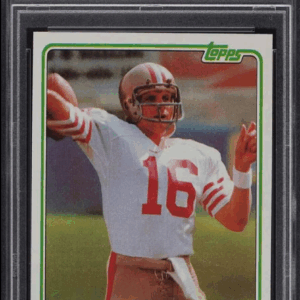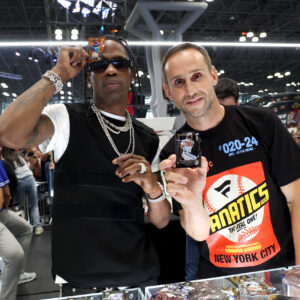In the exhilarating world of sports card collecting, few items inspire as much fervor and fanaticism as Joe Montana’s 1981 Topps rookie card. Decades after Montana last hurled a pigskin down the field, his legacy continues to ripple through the fabric of American football and reverb in the bustling card market.
Donned in his iconic red-and-gold San Francisco 49ers jersey, Montana’s visage on this particular card has become an emblem of sporting excellence. Indeed, “Joe Cool,” as he was affectionately dubbed, was instrumental in shaping the NFL landscape during the 1980s. With his unflappable demeanor and clutch performances, he led the 49ers to four spectacular Super Bowl victories, all while etching his name into the annals of athletic heroism. Therefore, it’s hardly a surprise that collectors with an eye for history hold his rookie card in the highest regard.
Yet, it’s not just nostalgia driving up the demand. There is a tangible allure in the numbers. For the pristine, highly coveted PSA 10 grade cards, only a scant 115 copies exist. Yet, despite their rarity, four of these gems have exchanged hands in the last quarter alone, catapulting their value by nearly 17 percent to a staggering recent peak of $48,800. This is a colossal leap from 2005, when a PSA 10 Montana card demanded a humble $4,075. In today’s market, that’s a jaw-dropping 1,097 percent increase—one that raises eyebrows brighter than a neon jersey under Friday night lights.
However, the appeal of Montana’s rookie card isn’t restricted to just the crème de la crème of the grading scale. Troves of PSA 9 cards exist in greater abundance, with over 2,100 specimens counted. Interestingly, their story is not dissimilar to their loftier PSA 10 counterparts. Recent sales have shown a healthy bump up to $2,035, marking an 11 percent increment merely within the last three months. A deep dive into the past reveals these same PSA 9 cards were once yours for about $300 back in 2010—an impressive 578 percent gain that might make stock market investors second guess their portfolios.
But what about those more ubiquitous PSA 8 cards? They number almost 10,000, a population seemingly less exclusive. Even so, recent sales have ranged from $290 to an admirable $431. The latest sale pinned down a price of $329. Unlike their more pristine siblings, however, PSA 8s have seen a slight dip, edging down by 5 percent this past quarter. Yet, holding one of these cards can still be seen as possessing a piece of historical brilliance fit for a museum shelf or a personal mantle.
Why the unrelenting buzz around these cards? It circles back to Joe Montana’s enduring influence—an athlete who transcended the boundaries of mere sports stardom to become an emblem of excellence and an ambassador of football. Collectors, both seasoned and novices drawn into the magnetic world of sports memorabilia, see his 1981 Topps rookie card as more than just cardboard and ink. It’s a storyline, a passage to an era marked by sporting genius and historic triumphs.
Within this landscape, these Joe Montana rookie cards have become timeless treasures. They remind us that greatness, in whatever form it takes, remains resiliently valuable and perennially sought after. As new generations discover the history of American football, as well as its most significant figures, Joe Cool’s legacy becomes cemented not just in the hearts of fans but perpetually within the fluctuating yet fascinating world of trading cards.
These little pieces of history encapsulate more than just imagery; they spin the tale of an illustrious career and the echoes of victory that resound far beyond the stadium. In Montana’s gleaming grin and poised throwing stance, collectors find not just investment potential, but a gateway to relive the golden moments of football’s storied past—a wanderlust for nostalgia that shows no signs of quieting down.






